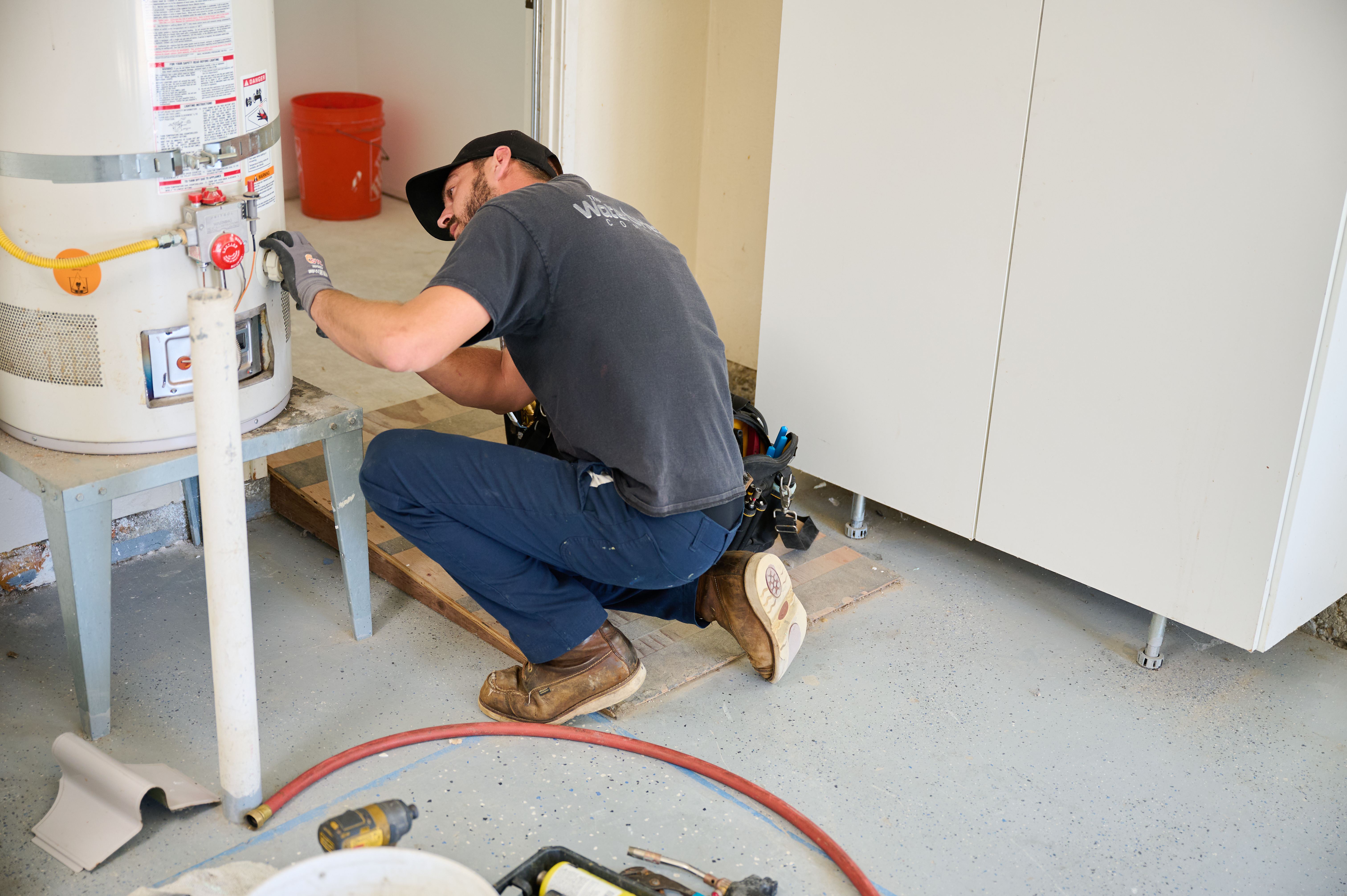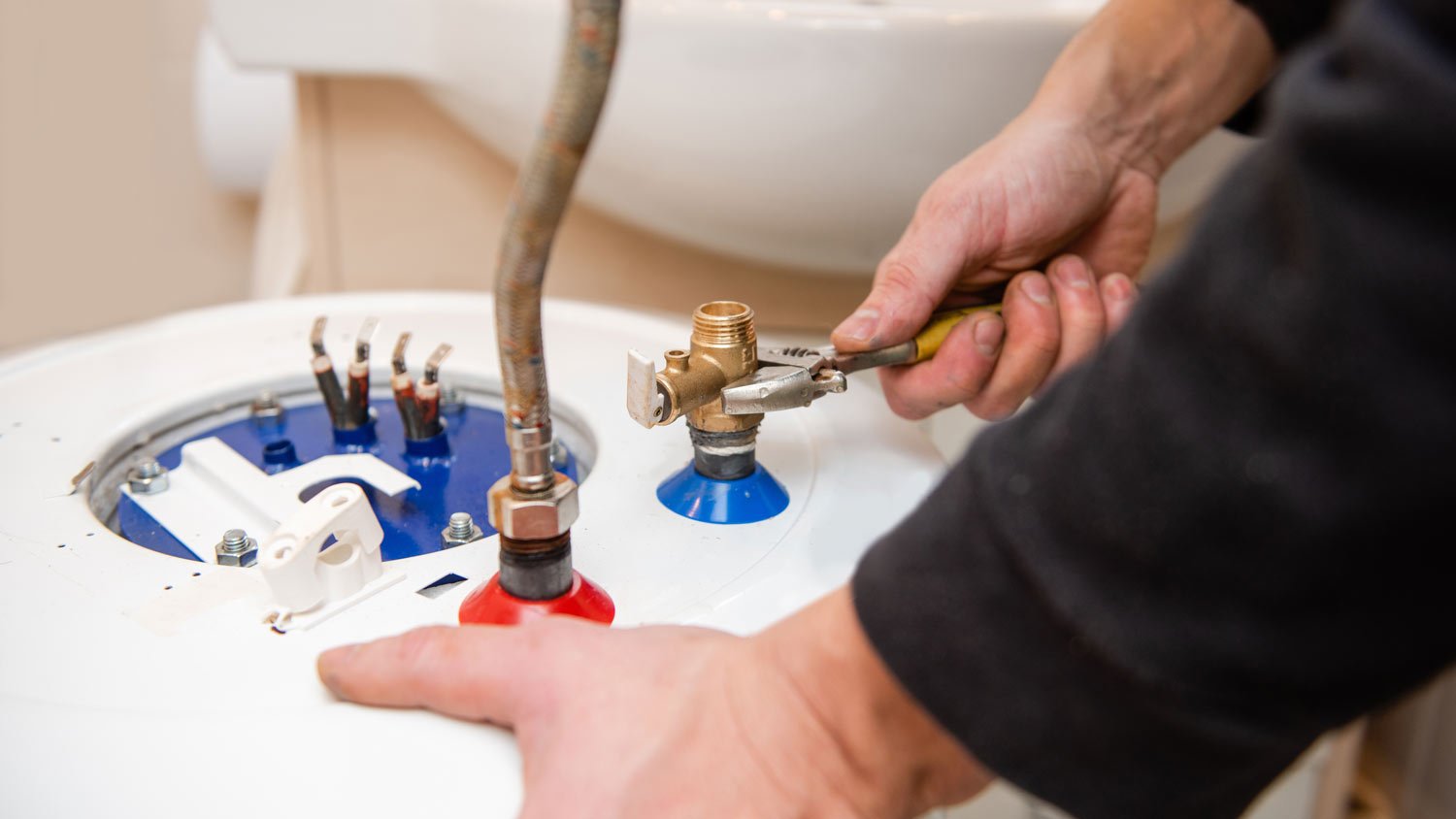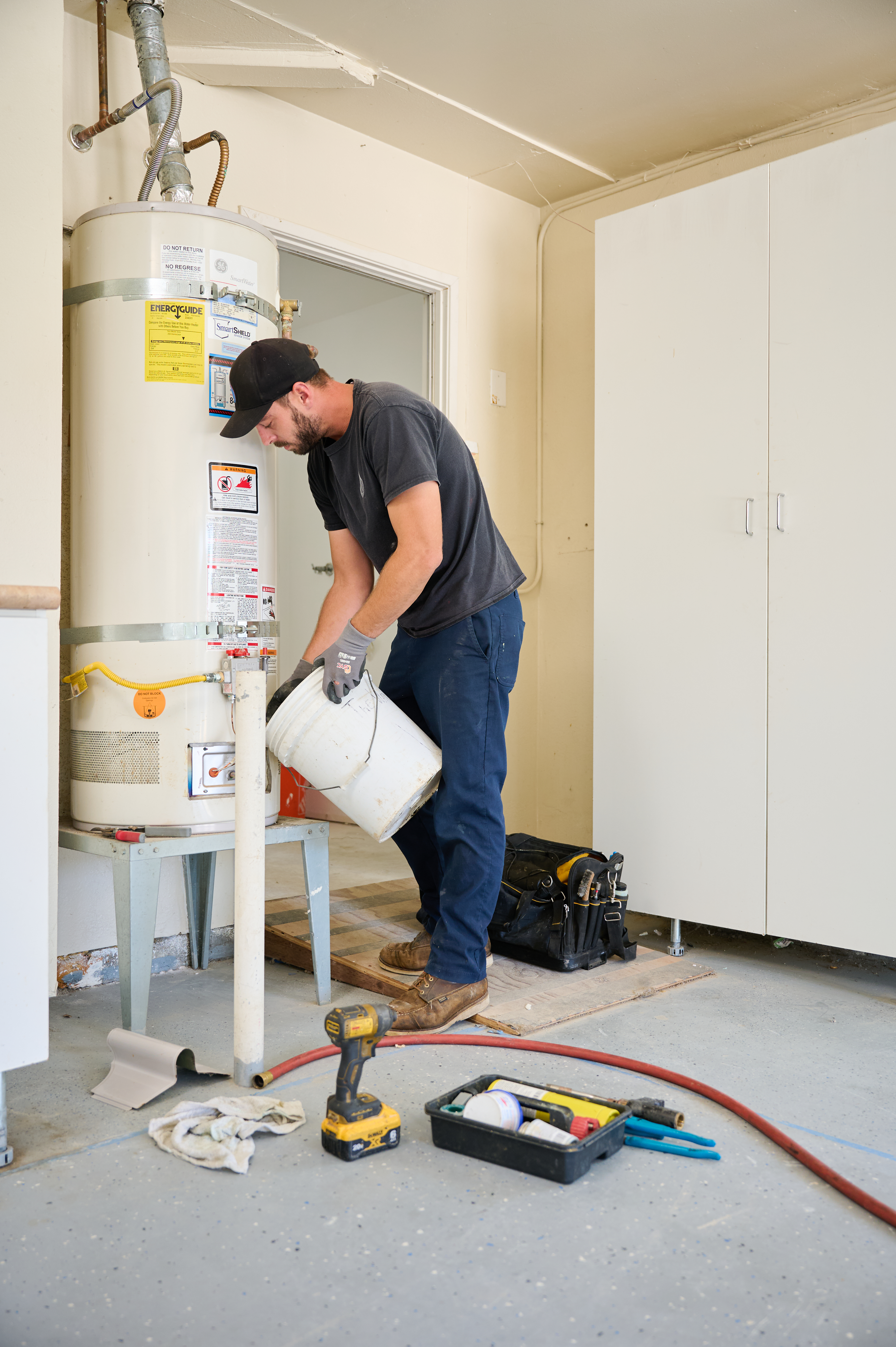
Tankless water heater costs in Columbus, OH depend on the size of your water heater, location, fuel type, and more. Keep reading to calculate your expenses.
Stay out of hot water—let a pro handle this installation


Among the many pros and cons of a tankless water heater, its complex installation definitely makes our con list. Sure, a tankless water heater's compact design may make it look like a DIY job, but it is always best—and sometimes legally required—to leave it to the professionals. From gas line and electrical upgrades to water heater code violations, the cost savings will rarely outweigh potential dangers. All this being said, understanding the process of how to install a tankless water heater can help you prepare for your HVAC pro's visit, and—and only if you have advanced experience—take it on yourself.
Tankless water heaters are still relevantly new to the market. Unlike conventional water heaters, these modules are compact and more energy efficient as they only heat water as needed. On average, tankless water heaters cost $2,523 on average, including labor. An electric tankless water heater costs between $170 to $800, and a gas tankless water heater goes anywhere from $750 to $2,300, labor not included. Gas heaters heat water more quickly than electric ones, although they require more maintenance and are harder to install.
There are several reasons to replace your water heater, but the bottom line is usually because you need one. Tankless gas or electric tank-style water heaters have a lifespan between 15 and 20 years when properly maintained. Its longer life is just one of the perks that balance the cost of making the switch. The main reasons to decide it’s time for a new tankless water heater include water leaking from the unit, old age, a growing family that uses more water, shorter hot water durations, and saving energy costs with a more efficient heater.
A basic water heater installation costs between $1,000 to $3,500. If you need to modify or upgrade any existing lines, your plumber will charge the additional work by the hour. The same goes for switching from a gas water heater to an electric water heater. You also need to hire an electrician if new wiring or outlets are required.
You must first find a suitable tankless water heater for your home. To make your decision, factor into the following aspects:
Gas or electric power
Gallons per minute (GPM) required for your home
Need for temperature rise
Because tankless water heater heats water on demand, it is crucial to know how much hot water supply your home needs, measured by gallons per minute (GPM). Common appliances in your home have the following average flow rate:
Bathroom faucets: 1 to 2 GPM
Kitchen sink: approximately 2 GPM
Dishwasher: approximately 2 GPM
Showerheads: 2 to 3 GPM
Washer: 2 to 3 GPM
On average, a residential home needs a tankless water heater capable of supplying 6 to 7 GPM to provide hot water simultaneously to all outlets if needed. A more upgraded home might be looking at around 8 GPM. Make sure the tankless water heater you purchase meets the GPM requirements for your home.
Another metric that affects your tankless water heater’s size, model, and price is groundwater temperature. Your water heater must cover the temperature difference between the groundwater and desired hot water temperatures. If you live in colder climates, you will need a more powerful tankless water heater than those in warm and hot areas.
Installing a tankless water heater yourself is a serious job. Therefore, ensure you have all the necessary tools and equipment before you start.
If you upgrade from a water heater to a tank, you need a hand truck to help with removal. Also, ensure you have a hose, a bucket, and some cleaning supplies, as you’ll need to drain your old water heater before removing it. For the installation, you only need a pipe wrench, a drill, and a keyhole saw to complete the job. However, we recommend leaving this project to the professionals.

To install a tankless water heater, you will begin by removing your old water heater. If you stick with a gas-powered water heater, you must upgrade your gas supply line. New wiring and outlets would become necessary if you switch to an electric water heater. Once the tankless water heater is mounted, you must install new water lines.
Depending on the model, a few additional steps may be needed. For a gas tankless water heater, you will need:
A sufficient gas supply line
A vent to remove combustible gas
An electrical outlet to power the unit
For an electric tankless water heater, you will need:
A circuit panel with sufficient amperage
An electrical outlet
Ground conductors
Finally, always test your water heater before calling the job done. It’s better to be safe than sorry!
Before you begin, ensure all lines are turned off. If you have an electric water heater, turn off the circuit breaker. If you have a gas heater, turn off the supply valve. You also need to turn off the water supply lines so no water floods out while you replace the water heater.
Next, drain your old water heater with a hose and a bucket. Once down, unscrew all connecting pipes, then remove old wirings and brackets. Try not to damage any existing wirings and pipes, so you don’t have to replace more parts. Use a hand truck to remove a tanked water heater.
If you are replacing a gas water heater with a storage tank with a tankless model, you will need to upgrade your gas line. Gas-powered tankless water heaters require more gas, sometimes more than the requirement of a large home furnace. In most cases, you will need a 1-inch line.
To upgrade your gas pipe, follow these steps:
Remove a portion of the thinner gas pipe
Cut out the larger pipe according to the length you need
Connect the larger pipe with the old pipe using the proper pipe fitting
Ensure the connections are sealed and there is no leakage
Meanwhile, if you are installing an electric tankless water heater, check to ensure your circuit panel is strong enough to power the new heater. You can find the required amperage and voltage in your water heater’s manual or on the packaging. Note that not all homes are capable of having an electric tankless water heater due to the high amp draw these units require.
Larger units will require thicker, stronger wires and multiple circuit panels, whereas smaller units can be connected to a single circuit. Regardless, each circuit will need a ground conductor linked to the unit’s grounding busbar and the breaker panel.
First, ensure you are installing your tankless water heater at a proper location. State and county building codes will tell you how much clearance is required around your water heater. If you are installing a gas tankless water heater, choose a location that allows it to vent directly to the outside. Usually, you can vent through your home’s rim joist.
Build a mounting box with lumber and plywood about four inches out from the wall on the outside. Make sure there is enough support for the weight. Mount the tankless water heater following the manufacturer’s instructions using the mourning accessories that come with your unit. Now, you are ready to connect the supply lines.
Follow the manufacturer’s instructions and connect waterlines to your new tankless water heater. Tie in new cold and hot water supply lines using copper pipes. Sand and clean the area and deburr the cut edge before moving forward. Dry-fit everything, apply flux to the assembled pipes and fittings, and solder them together. Use bell hangers as needed to secure the pipes along the wall for stronger support.
Now, you are ready to install the heat source.
If you are installing a gas tankless water heater, follow these steps:
Upsize your gas supply linnie as indicated in Step 2
Install a gas shut-off valve, tee, and sediment trap. Follow the manufacturer’s instructions and connect the valve and the sediment trap to your water heater.
Run a new gas supply line from the tee to an easy connection point to the new water heater’s gas line using a flexible gas supply line or black pipe.
Test the pressure with a pressure test gauge before turning on the gas!
Note that gas line installation can be dangerous and is best done by a licensed professional.
If you are installing an electric tankless water heater, follow these steps:
Inspect existing electrical wiring, circuit breakers, and connections.
Complete wiring following the wiring diagram in the manufacturer’s instructions.
Properly ground each unit.
Double-check all electrical connections.
Turn on the circuit breakers to power your tankless water heater
If you don’t fully understand the wiring diagram or any instructions in the manual, hire a professional installer or electrician!
All water heaters require a pressure relief valve. This is a safety device for purging the system if the water overheats and builds the pressure up too high. Meanwhile, the flow valve controls turn the water supply on and off. Install the pressure relief valve on the hot water side for electric tankless water heaters. For routine maintenance, consider installing a purge valve that will allow you to purge the system regularly.
You need to install an exhaust vent for a gas tankless water heater. The easiest solution is to use a vent kit. These kits come with sectioned stainless steel vent pipes, retaining rings, elbows, and other necessary supplies. While you may find PVC vent kits in the market, using a stainless steel vent for your tankless water heater is best.
Vent installation kits usually come with installation instructions. If you follow the steps, you can install the exhaust vent yourself. However, if you hire a professional to install the exhaust vent, the cost will be between $240 and $549.
You should always fully bleed the system before turning the water on. Open every hot water outlet in your house. This allows you to get rid of any air trapped in the system. Leave the outlets open for a few more minutes to complete bleeding. Don’t forget to shut the outlets after this is done.
Finally, it’s time to test your tankless water heater! Plug the water heater in, turn on the circuit breaker or the gas valve, and run your hot water! Sometimes, your tankless water heater may have a specific startup procedure. Follow those instructions to configure your water heater, and you will be set for the rest of the time.

Follow the recommended routine maintenance to get the most out of your tankless water heater. Make sure you purge the system at least once a year using the pressure relief valve. You should also flush your water heater annually to remove mineral build-ups. Most tankless water heaters also come with air and water filters. Both will need to be cleaned routinely for best performance. Additionally, give your tankless water heater a thorough exterior cleaning now and then to ensure no debris or dust builds up on it. Always turn off the power and water supply before wiping the water heater down.
While it is possible to install a tankless water heater yourself, we recommend that you hire a professional due to the professional expertise required and the dangerousity of the job. Installing a tankless water heater often involves professional plumbing and electrical work that is best done by a licensed professional.
Your easiest solution is to hire someone from a local tankless water heater company, as they will help you, from purchasing the proper model to completing installation. Alternatively, you can buy a tankless water heater on your own and then hire a plumber and an electrician separately for the installation. On average, a plumber will cost about $170 per hour, and an electrician will cost around $100 per hour.
From average costs to expert advice, get all the answers you need to get your job done.

Tankless water heater costs in Columbus, OH depend on the size of your water heater, location, fuel type, and more. Keep reading to calculate your expenses.

Find out the average tankless water heater repair cost, what impacts pricing, and how to save. Get expert tips to plan your repair budget with confidence.

Wondering how much a water heater expansion tank costs? Use this cost guide to get an accurate estimate and learn how to choose the right one for your home.

Is there water in your water heater pan? Why is my hot water heater leaking? We’ll review common causes for leaking water heaters—and what to do.

Learn the step-by-step process of resetting your water heater safely—our guide provides easy-to-follow instructions to help you restore your hot water supply.

Learn how much electricity the average water heater requires to run, plus how to calculate the daily and monthly cost to run your water heater.